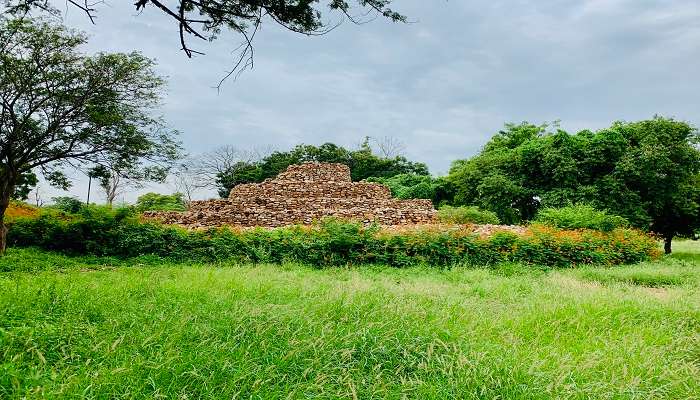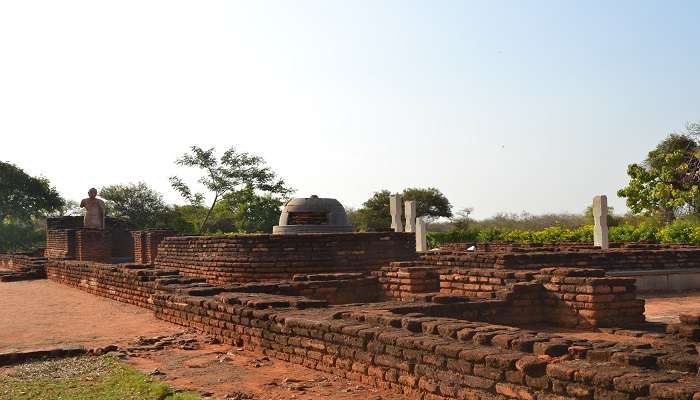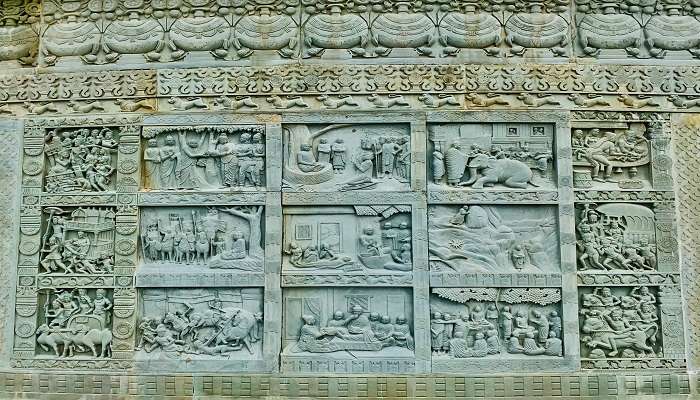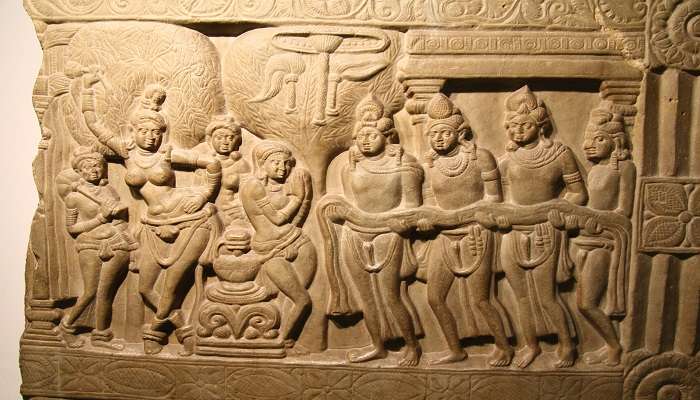Explore The City Of Nagarjunakonda Andhra Pradesh In 2026

In southern Andhra Pradesh, beside the Krishna River, lies Nagarjunakonda, an impressive archaeological site. It was once a thriving hub of Buddhist education and culture. Visitors can explore ancient structures that tell stories of their past. Named after the famous Buddhist monk Nagarjuna, who taught here in the 2nd century AD, Nagarjunakonda Andhra Pradesh represents India’s ancient religious and cultural richness. The site’s preserved ruins include large stupas, intricate caves carved into rocks, and remains of impressive monasteries, giving us a peek into a time when Buddhism thrived in this area. This article will uncover everything about the Nagarjunakonda Andhra Pradesh.
History Of Nagarjunakonda Andhra Pradesh

The site gained prominence after the Satavahanas declined in the first quarter of the 3rd century when the Ikshvaku king Vashishthiputra Chamamula established his capital, Vijayapuri. Coins and inscriptions discovered at Nagarjunakonda name four kings of the Ikshvaku dynasty: Vashishthi-putra Chamtamula, Matahari-putra Vira-purusha-datta, Vashishti-putra Ehuvala Chamtamula, and Vashishti-putra Rudra-purusha-datta. An inscription dated to the 30th regnal year of the Abhira king Vashishti-putra Vasusena has also been found at the ruined Ashtab-huja-swamy temple. This discovery has led to speculation that the Abhiras, who ruled the region around Nashik, may have invaded and occupied the Ikshvaku kingdom, although this remains uncertain. The Ikshvaku kings constructed temples dedicated to deities such as Sarva-deva, Pushpabhadra, Karttikeya, and Shiva. Their queens and Buddhist upazilas, like Bodhishri and Chandra Shri, constructed numerous Buddhist monuments at the site. It is believed that Sadvaha authorised the first monastic construction at Nagarjunakonda.
The site housed more than 30 Buddhist viharas during the early centuries. Excavations have yielded artworks and inscriptions of great significance for scholarly study of this early period. The last extant Ikshvaku inscription is dated to the 11th year (c. 309 CE) of Rudra-purusha. The subsequent fate of the dynasty is unknown. Still, it is possible that the Pallavas conquered their territory by the 4th century. The site declined after the fall of Ikshvaku’s power. Some brick shrines were constructed in the Krishna River valley between the 7th and 12th centuries when the Chalukyas of Vengi controlled the region. Later, the site became part of the Kakatiya Kingdom and the Delhi Sultanate. During the 15th and 16th centuries, Nagarjunakonda regained importance. In 1515, the Vijayanagara king Krishnadevaraya stormed the fortress during his invasion of the Gajapati kingdom. The Qutb Shahi dynasty and the Mughals later ruled the region. Thus, Nagarjunakonda, Andhra Pradesh, has a rich history.
Must Read: Lambasingi In Summer
Top 3 Places To Visit In Nagarjunakonda Andhra Pradesh
When visiting the Nagarjunakonda Andhra Pradesh, there are several nearby attractions that you must add to your basket list. Some of the top places include:
1. Dhamma Nagarjuna

Dhamma Nagajjuna is not a traditional tourist destination. It’s a Vipassana meditation centre located in Telangana, about 160 kilometres from Hyderabad. Established in 2004, it’s named after the great scholar Acharya Nagarjuna.
The centre offers Vipassana meditation courses, a practice aimed at mental purification through self-observation. Courses typically last ten days and involve strict discipline, including noble silence (no talking to other participants). There are no touristy activities around the centre, and it’s not recommended for those seeking a vacation. However, if you’re interested in experiencing Vipassana meditation in a peaceful and serene environment, Dhamma Nagajjuna could be a good option.
Location: J7JP+6CQ, Nagarjuna Sagar Rd, beside Buddha Vanam Project, Hill Colony, Nalgonda, Sunkishala, Telangana 508202
Entry Fees: Free
Best Time to Visit: October to March
2. Kaman Bazaar

Kaman Bazaar in Nagarjunakonda Andhra Pradesh, is a lively marketplace renowned for its wide variety of clothing and accessories. It attracts tourists eager to experience local trade and culture. Close by, Gandhi Chowk is the main hub for jewellery trade, enhancing the area’s commercial appeal.
In addition to shopping, visitors can explore historical sites like Khammam Fort and Narasimha Swamy Temple or enjoy the natural beauty of Palair Lake. With its blend of shopping, history, and scenic attractions, Kaman Bazaar offers travellers a comprehensive and immersive experience of the region’s unique offerings.
Location: Braman Bazar, Nizampet, Khammam, Telangana
Entry Fees: Free
Best time to visit: October to March
Suggested Read: Shopping In Vijayawada
3. Gandhi Chowk

Gandhi Chowk in Nagarjunakonda Andhra Pradesh, is famous for its jewellery market, offering a wide range of traditional and contemporary designs. This bustling marketplace is a haven for shoppers and a cultural hotspot that provides a glimpse into the local lifestyle.
Visitors can enhance their experience by also visiting nearby attractions such as the world’s largest masonry dam, Nagarjunasagar Dam, and exploring the historical Khammam Fort and Narasimha Swamy Temple. The combination of commerce, craftsmanship, and culture makes Gandhi Chowk a must-visit destination for anyone exploring the region.
Location: Old, Bus Stand, Dhone, Andhra Pradesh 518222
Entry Fees: Free
Best Time to Visit: October to March
Best Time To Visit Nagarjunakonda Andhra Pradesh

Nagarjunakonda experiences a tropical climate throughout the year. This means hot and humid summers, interspersed with a brief monsoon season, and pleasant winters.
- Summer (March to June): The summer months in Nagarjunakonda are scorching, with temperatures soaring up to 45°C. The relentless heat and humidity can make sightseeing quite uncomfortable, even for those who can tolerate extreme heat. It’s best to avoid visiting during this time.
- Monsoon (July to September): The monsoon season brings moderate to heavy rainfall to the region. While the rain provides a respite from the summer heat, it can also lead to occasional flooding and disrupt travel plans. Additionally, some outdoor activities and exploration of the historical sites might be hampered.
- Winter (October to March): This is undoubtedly the best time to visit Nagarjunakonda. The winter months offer pleasant weather with temperatures ranging from a comfortable 15°C to a maximum of 30°C. This makes exploring the Buddhist monuments, caves, and surrounding areas much more enjoyable.
Suggested Read: Valleys In Andhra Pradesh
How To Reach

One can reach Nagarjunakonda Andhra Pradesh via the following ways:
By Air
The nearest airport to Nagarjunakonda is Vijayawada Airport, located approximately 65 km away. It has regular flights connecting it to major cities across India. Alternatively, Hyderabad Airport, which is about 165 km away, also provides good connectivity. From both airports, you can hire a taxi or take a bus to reach Nagarjunakonda.
By Road
Nagarjunakonda is well-connected by road. There are frequent state-run and private buses from Hyderabad, Guntur, and Vijayawada. You can also hire a car or taxi from these cities directly to Nagarjunakonda. Once there, taxis are available for local transportation and exploring the area.
By Train
The nearest railway station to Nagarjunakonda is Macherla Railway Station, which is 20 km away. It is connected to major cities via regular bus and taxi services. From Macherla, you can easily reach Nagarjunakonda by road.
By Waterways
From Vijayapuri, launches operate to Nagarjunakonda Hills, departing at 9:30 AM, 11:30 AM, and 1:30 PM and returning within an hour. This offers a scenic and exciting way to reach Nagarjunakonda.
Local Transport
To get around Nagarjunakonda affordably, use local buses. For easier travel, consider renting a cab or private vehicle for the day. Short-distance taxis are also an option for quick trips to specific places nearby.
Further Read: Islands In Andhra Pradesh
Besides its history, Nagarjunakonda is also known for its beautiful natural surroundings and calm atmosphere, which make it perfect for a peaceful getaway. Are you ready to immerse yourself in the wonders of Nagarjunakonda, Andhra Pradesh, and experience the vibrant culture? So, why wait? Book your trip to Andhra Pradesh today. Andhra Pradesh has many historical sites, stunning landscapes, and friendly people, making it a memorable place to visit. Don’t hesitate; plan your trip now to discover the hidden gems of this wonderful part of India.
For our editorial codes of conduct and copyright disclaimer, please click here.
Cover Image Credit:Ms Sarah Welch for wikimedia commons
Frequently Asked Questions About Nagarjunakonda Andhra Pradesh
What is Nagarjunakonda in Andhra Pradesh famous for?
Nagarjunakonda is famous for being one of India's richest Buddhist sites. It boasts the remains of ancient Buddhist monuments dating from the 1st to 3rd centuries CE, including stupas, monasteries, and statues. The site is also significant for its association with the renowned Buddhist scholar Nagarjuna, who lived in the 2nd century AD and is believed to have been a key figure in the development of Mahayana Buddhism.
Which is the nearest train station to Nagarjunakonda?
The nearest train station to Nagarjunakonda is Nagarjuna Sagar, which is approximately 15 kilometres from the island.
Is Nagarjunakonda a neolithic site?
No, Nagarjunakonda is not primarily a neolithic site. While some megaliths dating back to the 2nd century BCE have been found there, the most significant archaeological remains belong to the Buddhist civilization that flourished centuries later.
Which river is Nagarjunakonda in?
Nagarjunakonda was originally located on the banks of the Krishna River. However, the area was flooded when the Nagarjuna Sagar Dam was constructed. Nagarjunakonda is now an island amid the resulting reservoir.
Who built the stupa at Nagarjunakonda?
The Andhra dynasty, rulers of southern India after the Mauryan era, constructed the Nagarjunakonda stupa. This stupa stands out for its distinctive design, with a circular base and a square peak embellished with detailed sculptures. Additionally, Ikshvaku princess Chamtisiri refurbished the stupa in the 3rd century AD, enhancing it with stone Ayaka pillarsAyaka pillars.
People Also Read:
Places To Visit In Andhra Pradesh Places To Visit In Summer In Andhra Pradesh Things To Do In Andhra Pradesh

Unveil the hidden treasures of the globe and turn every travel dream into reality. As a Content Writer, I am passionate enough to craft stories from ancient wonders to modern marvels. My words paint the picture-perfect itinerary for unforgettable experiences. Let my words be your trusted guide to immerse in the diverse culture and discover the beauty of the unknown.











